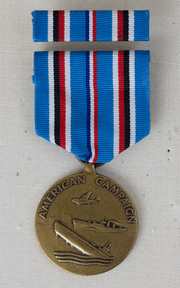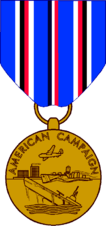American Campaign Medal
| American Campaign Medal | |
|---|---|
|
American Campaign Medal | |
|
Awarded by Department of the Army Department of the Navy | |
| Type | Service medal |
| Eligibility |
served in the armed forces in the American theater area between the following dates:
|
| Status | Inactive |
| Statistics | |
| First awarded | December 7, 1941 |
| Last awarded | March 2, 1946 |
| Precedence | |
| Equivalent |
Asiatic-Pacific Campaign Medal European-African-Middle Eastern Campaign Medal |
| Next (lower) | World War II Victory Medal |
|
American Campaign Medal service ribbon and streamer | |
The American Campaign Medal is a military award of the United States Armed Forces which was first created on November 6, 1942 by Executive Order 9265 issued by President Franklin D. Roosevelt.[1][2] The medal was intended to recognize those military members who had performed military service in the American Theater of Operations during World War II.[2] A similar medal, known as the American Defense Service Medal was awarded for active duty service prior to the United States entry into World War II.
History
The American Campaign Medal was established per Executive Order 9265,6 November 1942, by President Franklin D. Roosevelt and announced in War Department Bulletin 56, 1942. The criteria was initially announced in Department of the Army (DA) Circular 1, dated 1 January 1943, so that the ribbon could be authorized prior to design of the medal. The criteria for the medal was announced in DA Circular 84, dated 25 March 1948 and subsequently published in Army Regulation 600-65, dated 22 September 1948. The American Campaign Medal was issued as a service ribbon only during the Second World War, and wasn't issued as a full-sized medal until 1947.[2]
The first recipient of the American Campaign Medal was General of the Army George C. Marshall, Jr.[2]
Criteria
The requirements for the American Campaign Medal were for service within the American Theater between 7 December 1941 and 2 March 1946 under any of the following conditions:[1]
- On permanent assignment outside the continental limits of the United States.
- Permanently assigned as a member of a crew of a vessel sailing ocean waters for a period of 30 consecutive days or 60 nonconsecutive days.
- Outside the continental limits of the United States in a passenger status or on temporary duty for 30 consecutive days or 60 nonconsecutive days.
- In active combat against the enemy and was awarded a combat decoration or furnished a certificate by the commanding general of a corps, higher unit, or independent force that the Soldier actually participated in combat.
- Within the continental limits of the United States for an aggregate period of 1 year.
The boundaries of American Theater are as follows: The eastern boundary is located from the North Pole, south along the 75th meridian west longitude to the 77th parallel north latitude, thence southeast through Davis Strait to the intersection of the 40th parallel north latitude and the 35th meridian west longitude, thence south along the meridian to the 10th parallel north latitude, thence southeast to the intersection of the Equator and the 20th meridian west longitude, thence south along the 20th meridian west longitude to the South Pole.
The western boundary is located from the North Pole, south along the 141st meridian west longitude to the east boundary of Alaska, thence south and southeast along the Alaska boundary to the Pacific Ocean, thence south along the 130th meridian to its intersection with the 30th parallel north latitude, thence southeast to the intersection of the Equator and the 100th meridian west longitude, thence south to the South Pole.
Appearance
 |  |
The medal, made of bronze, is 1 1/4 inches wide. The obverse was designed by Thomas Hudson Jones. It shows a Navy destroyer underway with a B-24 Liberator bomber flying overhead. In the foreground is a sinking enemy submarine, and in the background is the skyline of a city. At the top of the medal are the words AMERICAN CAMPAIGN. The reverse of the medal, designed by Adolph Alexander Weinman, is the same design as used on the reverse of both the Asiatic-Pacific Campaign Medal and the European-African-Middle Eastern Campaign Medal. It depicts an American bald eagle between the dates 1941 - 1945 and the words UNITED STATES OF AMERICA.[2]
The ribbon is 1 3/8 inches wide in oriental blue in the center is a 1/8 inch center stripe divided into thirds of old glory blue, white, and scarlet. Between the center and the edges are stripes of 1/16 inch in white, black, scarlet and white. The blue color represents the Americas; the central blue, white and red stripes, taken from the American Defense Service Medal ribbon, represents the continuance of American defense after Pearl Harbor. The white and black stripes represent the German part of the conflict on the Atlantic Coast, while the red and white stripes are for the Japanese colors and refer to that part of the conflict on the Pacific Coast.[2]
Devices
3/16 inch service stars were authorized to service members who participated in combat with Axis forces within the American theater. This primarily applied to those service members whose units participated in anti-U-Boat patrols (Anti-submarine warfare) in the Atlantic.[3]
Campaigns
Navy campaigns
Participation in these escort, antisubmarine, armed guard, and special operations entitle recipients to one campaign star for each participation:[4]
| Navy Campaigns | |||||||||||||||||||||||||||||||||
|---|---|---|---|---|---|---|---|---|---|---|---|---|---|---|---|---|---|---|---|---|---|---|---|---|---|---|---|---|---|---|---|---|---|
| |||||||||||||||||||||||||||||||||
Army campaigns
A bronze service star is authorized for participation in the antisubmarine campaign. To qualify individuals must have been assigned to or attached to, and present for duty with, a unit with antisubmarine campaign credit.[2]
Bibliography
- Foster, Frank C. (2002). A complete guide to all United States military medals, 1939 to present. Fountain Inn, S.C.: MOA Press. ISBN 1-884-45218-3. OCLC 54755134.
- Kerrigan, Evans E. (1971). American war medals and decorations. New York: Viking Press. ISBN 0-670-12101-0. OCLC 128058.
- Kerrigan, Evans E. (1990). American medals and decorations. Noroton Heights, CT: Medallic. ISBN 0-792-45082-5. OCLC 21467942.
- Robles, Philip K. (1971). United States military medals and ribbons. Rutland, VT: C. E. Tuttle. ISBN 0-804-80048-0. OCLC 199721.
References
| Wikimedia Commons has media related to American Campaign Medal. |
- 1 2 Army Regulation 600–8–22 Military Awards (PDF). Washington, DC: Headquarters Department of the Army. 24 June 2013. p. 68. Retrieved 2014-01-09. Check date values in:
|year= / |date= mismatch(help) - 1 2 3 4 5 6 7 "American Campaign Medal". The Institute of Heraldry. Retrieved 9 January 2014.
- ↑ "Title 32 - National Defense § 578.50 American Campaign Medal.". Government Printing Office. Retrieved 18 March 2013.
- ↑ "American Campaign Medal". Navy History and Heritage Command. Retrieved 18 March 2013.
